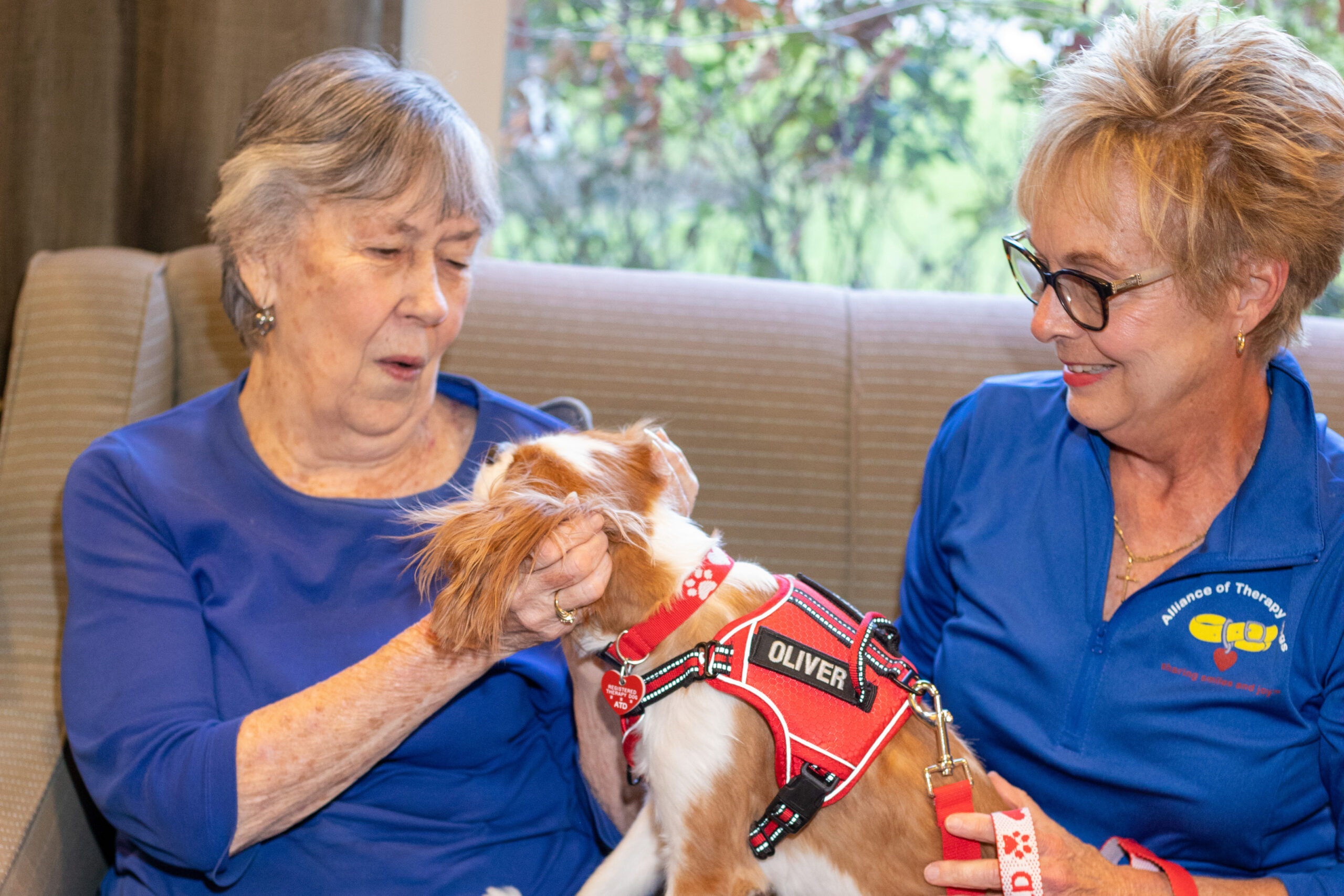
Tom and Gail’s unexpected journey to become therapy dog handlers began with sadness. Their Westie, Buddy, died at age 17, and the family was grieved. “We only lasted one night without a dog,” Gail says. The next day, they rescued a blue heeler they named Gus, but that was only the beginning. Tom, a United Airlines pilot, and Gail, a retired schoolteacher, have always been surrounded by pets, so having more than one dog was not out of the question–and Gail wanted to raise a puppy. She thought it would be best to wait until she retired so she would be home during the day, but in 2020–Gail’s final year of teaching–the pandemic shut-down forced her to teach from home after spring break. So, when her brother Harold Thompson, a Dallas architect, suggested they each get a puppy, she was ready.
But what kind of dog? Harold told Gail, “I am going to look, and you look, and we’ll talk.” A day or two later, he called and asked, “What do you know about Cavalier King Charles Spaniels?” Gail was stunned; she had been considering the same breed.
In 17th century England, King Charles I and King Charles II were known for their affection for their toy spaniels, which were eventually named after the younger King Charles. Originally hunting dogs, the small spaniels were popular among the British aristocracy, including the Duke and Duchess of Marlborough, who bred a brown and white variety at Blenheim Palace. After hundreds of years, however, the dogs didn’t look much like the painted portraits on the walls of manor houses. When a wealthy American offered British breeders cash incentives to breed “Blenheim spaniels of the Old World-type” in the 1900s, there were many takers. This new version of the original breed was eventually called the Cavalier King Charles Spaniel.
Despite their regal past, Cavaliers are even-tempered and affectionate, and as friendly to strangers as they are to their own people. They are athletic, yet gentle. Cavaliers have rabbit-soft fur, but are perhaps most noted for their large, round eyes and soulful expression. Each of four distinct color patterns is named for a British noble family.
Harold and Gail each chose a brown and white puppy (the Blenheim variety) from a breeder in Dallas; however, when the puppies were almost old enough to leave their mothers, Harold, who lives in a mid-rise apartment in Dallas, suddenly had second thoughts. Gail, with Tom’s blessings, decided to take Harold’s advice: both Cavalier puppies, Tucker and Oliver, soon joined the Tyler family.
Being a public-school teacher was always a main part of Gail’s identity, so she wondered if she would be able to find something meaningful to do after she put away her chalk and lesson plans. “I felt like teaching was a calling. It was a job, yes, but it was a calling–and I had a purpose. The public schools need Christian teachers,” she says. Gail, however, didn’t want to volunteer randomly. “I wanted to do something I was passionate about. People do their best when they are passionate about what they’re doing.”
Soon after retirement, Gail fulfilled one of her goals by joining Bible Study Fellowship (BSF), a worldwide, inter-denominational Bible study. One day, she struck up a conversation with another member of her BSF group. When talk turned to the woman’s involvement with therapy dogs, Gail was awestruck. Immediately, she thought, “This is what I’m supposed to do.” She remembered that, on long walks during the pandemic, people were drawn to Tucker and Oliver. “They are like little people magnets,” she says. “Part of it is because it’s two of them, and that’s a novelty, but part of it is the breed. All dogs have a connection with people, but if you talk to anybody who has had a Cavalier, you can’t explain it. They are totally devoted to their people. They are so affectionate, and they love everybody. Until you have had one of these dogs, it’s unexplainable the relationship you have with them. There’s something different about these dogs.” Tom agrees. “They look at you right in the eye,” he says. “It’s like looking at a human. I talk to Tucker, and he looks me right in the eye. He’s listening and understanding.”
While service dogs are highly-trained to help people with specific disabilities, therapy dogs are trained to bring joy and encouragement to seniors, students, and anyone else who is experiencing sadness. Tom and Gail soon learned that Cavalier spaniels–with their calm, loving personalities–are ideally suited to this role. After Tucker and Oliver completed a six-week obedience class at The Fundamental Dog in Magnolia, the Tylers believed the dogs were ready to become certified therapy dogs. Through trial and error, they found Alliance of Therapy Dogs, a national organization staffed mostly with volunteers. Soon, Tucker and Oliver—and Gail and Tom—passed three required evaluations with Kristie Niemi, a dog trainer who volunteers with Alliance of Therapy Dogs as a tester/observer. Tucker and Oliver showed that they could obey the commands of sit, stay, down, wait and walk, and Tom and Gail began looking for places for the dogs to spread joy.
In January 2021, the Tylers began visiting nursing homes. Today, they regularly visit Heritage Oaks and the memory care unit at Woodhaven Village Retirement Home in Conroe, as well as Live Oak Senior Care in Montgomery. Residents are thrilled to see the dogs; some tell Tom and Gail about dogs they used to own. “I enjoy seeing the smiles on those people’s faces. Sometimes they are staring off into space or watching TV, and it’s like flipping a switch for those people,” Tom says. “I love to see that.”
The visits are fun for everybody. “I think the staff looks forward to it as much as the residents do,” says Jacque Abrantes, activities coordinator at Live Oak. Therapy dog visits, however, may be much more than fun. A recent Swiss study revealed that live animals stimulate the frontal cortex of the brain—the part responsible for attention, working memory, and problem solving—much more than stuffed animals do. According to a report on CNN, the study suggested that animal therapy may supercharge some brain functions.
Because Gail taught for many years in Montgomery, the Tylers also began a pilot program at several Montgomery schools, bringing the dogs to classrooms and groups of at-risk students. Gail has fond memories of one student who found the school environment enormously stressful. “When she was with Tucker or Oliver, her entire demeanor changed. Staff members commented that they never got to see that smile,” Gail says. “The last time we saw her, she was holding Tucker, and she looked up and asked, ‘Do you think he knows how much I love him?’ Kids are dealing with a lot of stress. What we do doesn’t magically change a person’s life, but I believe it does give them moments of love and joy that inspire hope.”
While Tom and Gail bring Tucker and Oliver to many official therapy visits through Alliance of Therapy Dogs, they also do “unofficial” visits when shopping, walking in their Montgomery neighborhood, and going to pet-friendly restaurants. “We really feel like God puts everything in our lives for a purpose,” Gail says. “When he blesses us, it’s 20 times more of a blessing if we use it to bless others. It would be so selfish of us to keep these dogs to ourselves when they can bring joy to others. There are not that many things in our world that are pure joy.”
For more information, visit therapydogs.com and twocraftycavaliers.com, or email Gail at gailatyler@gmail.com.

Postcards Magazine
936-293-1188
PO Box 690
Huntsville, TX 77342
